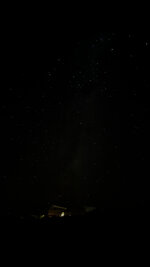Horizons was not even close to being accurate, the sky is filled with a gray fog or haze (making it blueish/purplish at times) as some like to call it, and the dust was really exaggerated and all over the place. Odyssey is not perfect, there should be millions of stars displayed, small sized nebulas should still be visible like in Horizons, the galaxy band should be white and the dust dark brown but at least the sky is black now and the dust is confined to the milky way band which is a huge improvement, Elite is supposed to be a simulation (it's not but at least it is somewhat close to it).
This is taken from the exact same spot and with the same FOV:
Horizons

Odyssey (alpha)

For what it is worth here is some pictures which are close to what you would see with the naked eye:





It should be like that in Elite (in that regard Space Engine is pretty accurate, really like it):
From Starry Night software, assembled from literally thousands of photographs; it's been imaged and processed to give the closest resemblance to what you'd see with the naked eye under dark skies.

360-degree panorama view of the Milky Way (an assembled mosaic of photographs) by ESO, the galactic centre is in the middle of the view, with galactic north up.

This is taken from the exact same spot and with the same FOV:
Horizons

Odyssey (alpha)

For what it is worth here is some pictures which are close to what you would see with the naked eye:





It should be like that in Elite (in that regard Space Engine is pretty accurate, really like it):
From Starry Night software, assembled from literally thousands of photographs; it's been imaged and processed to give the closest resemblance to what you'd see with the naked eye under dark skies.
360-degree panorama view of the Milky Way (an assembled mosaic of photographs) by ESO, the galactic centre is in the middle of the view, with galactic north up.





